Aqua LinQ Network Interface – Part 4 – Squeezelite

LMS Configuration
To use the LMS interface, launch it using any HTML5-compliant desktop or mobile browser on any device by typing the server’s IP address in the address bar and adding the port, usually :9000. Some server implementations (such as Antipodes AMS) also have a direct link on their web interface to open the associated LMS interface. To update to Material Skin, simply install it via LMS Settings/Plugins.
After that, the interface will run without further setup. LMS automatically connects with the Squeeze Server component on your NAS or Music Server and finds the Squeezelite player in the LinQ to provide instant Plug & Play functionality.
The only thing to look out for is that, as in the Highlander movies, “there can be only one…” One active LMS server at a time that is. When using native LMS, disable Squeeze support in Roon and vice versa.
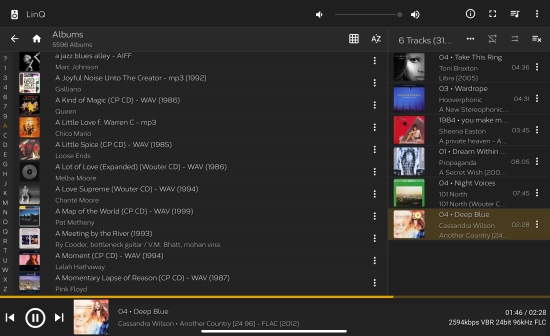
LMS offers all the usual functionality, such as browsing by Artist, Album, Genre, Years, and many other tags (all configurable in settings) and Folder browsing. The app also offers well-working Qobuz access, albeit not as deeply integrated as with Roon or JPLAY.
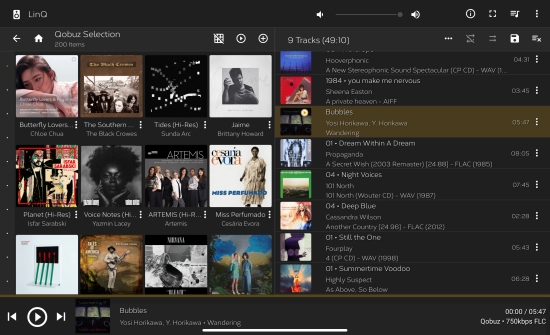
LMS also offers artist bios and reviews and even fetches a collection of artist images.
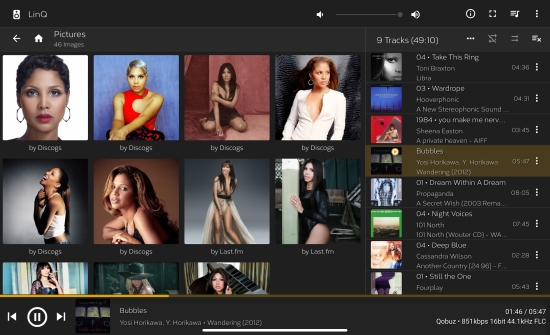
Roon Configuration
To use Squeeze as an output zone in Roon, first, make sure Logitech Media Server is not running and then enable Squeezebox support in Settings – Setup.
Enable the zone in Settings – Audio.
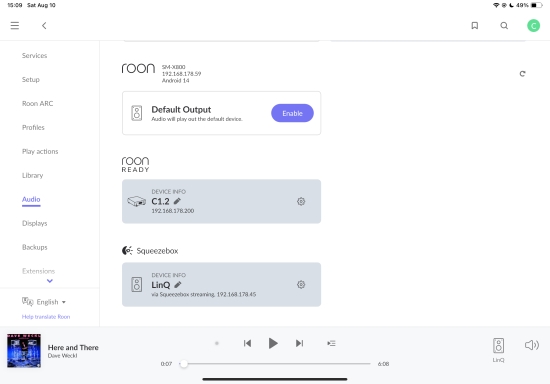
Make sure to deselect “Use FLAC Compression” (slide to off).

Finally, select the newly created zone as the output, and you’re done.
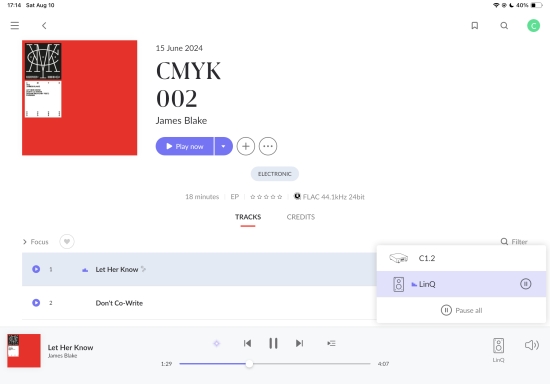
Innuos
I do not have Innuos equipment to test with, but according to Aqua, the Innuos Sense interface is compatible and works well.
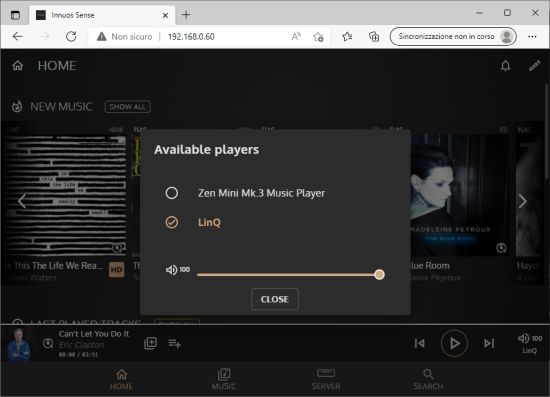
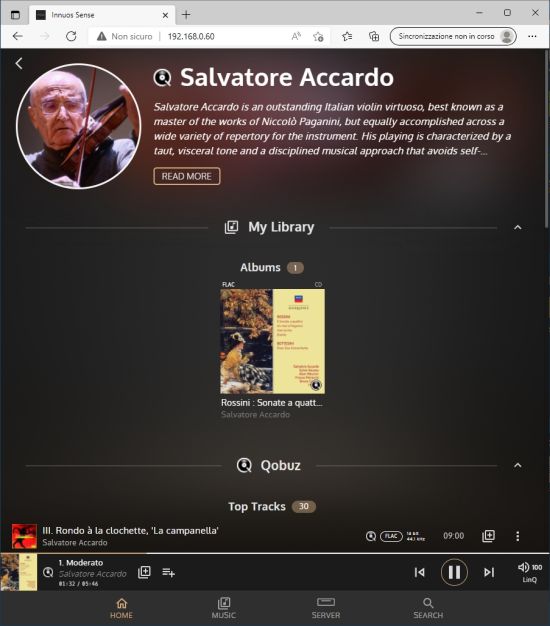
The sound of Roon/UPnP/Squeeze
When I first reviewed the Grimm MU1, it had the unique capability of making Roon sound similarly crisp and direct as the LinQ with UPnP, which is why I decided to add the server to my reference system. However, following later firmware updates to the server and ongoing changes to the overall Roon sound quality with every software update, I found myself increasingly drawn to UPnP.
The switch from Roon was made easy by the Antipodes Oladra music server, which can run pretty much any server/player software under the sun, including UPnP/MPD and Squeeze LMS/Squeezelite. The CH C1.2 DAC can be streamed to directly via UPnP and Roon and sounds very different depending on which of the two protocols is used. Interestingly, in 2021, the MU1 used to sound crisper and more articulate via its AES/EBU output, but now, in 2024, the C1.2 sounds slightly livelier when streaming from Roon to it directly. The C1.2 comes into its own when streamed to via UPnP, and that’s what I have been using the last few months, combined with MinimServer on the Oladra.
Back to the subject of this review, the Aqua LinQ also sounds fantastic with UPnP. It is slightly less fluid and refined than the C1.2’s streaming input but more energetic and highly engaging. These differences in presentation, which are subject to personal preference aside, I would say the LinQ performs on the same level as the CH DAC with this protocol. One of Squeeze’s attractive qualities, besides its well-thought-out Material Skin interface, is that it is very stable, more so than UPnP. Alas, the CH DAC is not compatible with Squeeze. But now, the LinQ is!
The LinQ remains my favorite network player, and now that it can also use Squeeze, I was curious to find out, first and foremost, how the sound of the new Squeeze module would compare to UPnP. Secondarily, I wanted to hear how Roon would perform streaming via Squeeze versus streaming via HQ Player Core + NAA.
Next: Review Context, Listening, and Conclusion
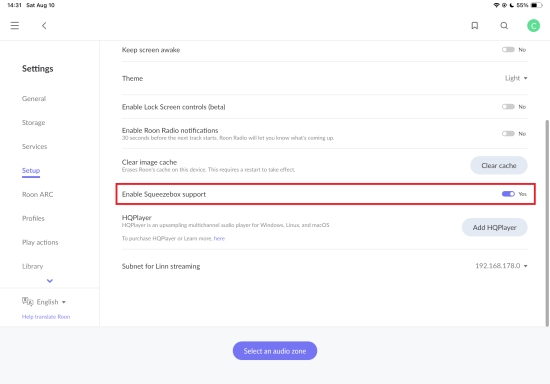






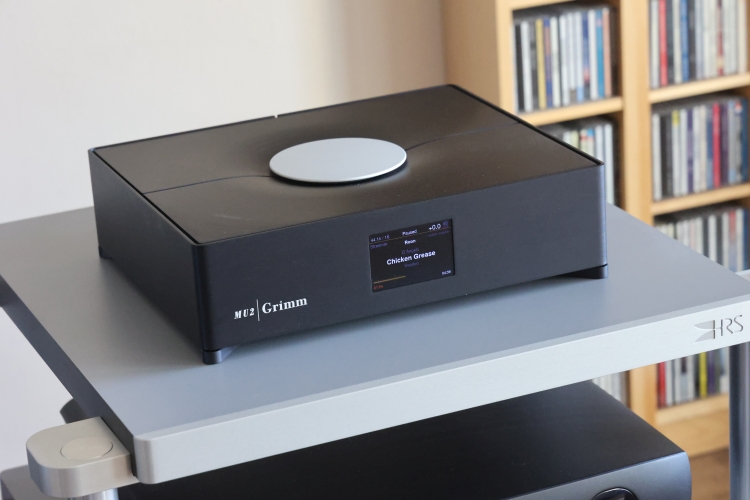
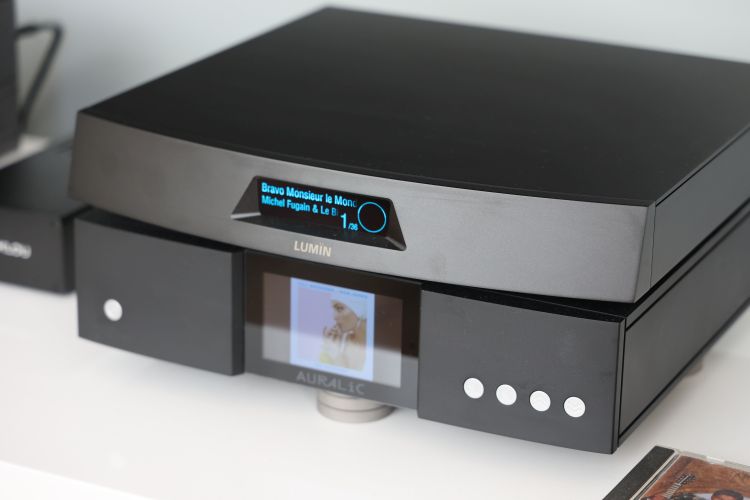
Hello Christiaan.,
Just read your new review regarding Aqua LinQ Network Interface -Squeezelite. And, you mentioned about Innuos Sense interface. If I’ll go for the LinQ as an endpoint renderer and have an Innuos Zen mk3, which I intend to use as a server, how could I connect both ? Innuos has only an USB connection for DAC and a RJ45 for connecting a streamer.
Could I use the RJ45 Aqua I2S connection ? this is the only way I guess
Hi Calin, The LinQ is a streaming endpoint, meaning that its input will always be a network connection. The protocol that can be used depends on the chosen module for the LinQ. The Innuos can function as a server, connected to a network switch. The LinQ also connects to a network switch on the same network, preferably the same switch. AQlink is no a network connection, it is Aqua’s implementation of teh I2S protocol. I2S was originally an IC to IC comms protocol. It carries separate data and clock signals, contrary to AES/EBU and S/PDIF. The downside of I2S is that it is not designed for long distances. This is what Aqua have addressed with their AQlink implementation.
And on more question please: if I don’t intend to enable and use Roon, could I go for the HQ player only ? with using same cofiguration described above ? Which module do I need inside LinQ ?
If your server supports HQP (either standalone or as part of another music software application), then you can use the LinQ with the HQP module. There are two options for that: basic and Core + NAA. There’s more information in my earlier installments of the LinQ review.
Alternatively, easier solutions are to use Squeeze server (LMS) with the Squeeze module, or MinimServer (UPnP) with the UPnP module.
Hi Christiaan
Are the cables used in this test still belden 19364 2.1mm and Oyadie c004 and Bals Schuko? I recently bought a belden 19364 cable, and the sound is very neutral and I am very satisfied. May I ask if you have connected the shield wire and ground wire in the cable to the ground terminal of the tail Oyadie C004? In addition, the European standard plug model of Bals Schuko is 7370, right? Thank you
Hi Nicholas, actually, I started using different cables and only still use the Belden for the A1.5 power amp. If you follow the “Main System” link in the review, you will see a Setup Snapshot page detailing all components and cables used at the time of that review.
Brand-name cables used:
– GigaWatt LC-2 EVO (with CH C1.2 DAC)
– GigaWatt PowerSync ULTRA (with CH L1 preamp)
– Belden 19364 with Bals schuko and Oyaide C004 IEC connectors (with A1.5 power amp)
The other components use one of the two following home-made cables:
– Block CUL 500 Enamelled solid core copper in PTFE tubing w. OEM Rhodium schuko and Oyaide 004
– OEM tinned litze in PTFE dielectric with OEM Rhodium-plated schuko and Oyaide 004
The Bals schukos I used were always Type 73 but these have been discontinued a few years back. They are superseded by the 7370. The older 73s sound a little leaner and faster, the newer ones have a little more voluminous tone.
I always attach the shield drain wire only to the wall/power-distributor side’s earth connector, not on the component side. I like the OEM Rhodium schukos a little more, they are more like the old Bals schukos and just a tad brighter, but given that they are sourced from Aliexpress and are not branded, there’s no telling what make they are.
Hello, great reviews. I really enjoy your content. I’m looking at the Antepodes k22 and the Aqua LinQ as my next transport and wondering if you would be able to compare and contrast their sound characteristics and performance? I’m upgrading DACs and looking at the MSB Discrete to pair with either transport.
Hi Javier, please see the Antipodes reviews for all comparisons I did.
Hello Cristiaan,
If using JPlay only, no Roon, which module ultimately gives the best sound, HQP Core + NAA or UPnP DLNA module?
Between HQP+NAA via Roon and UPnP native, I prefer the latter for its purer sound. However, I have only listened to the former using Roon, which also affects performance.